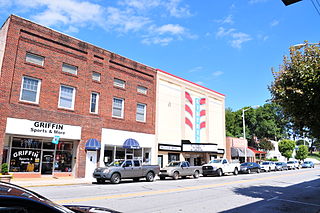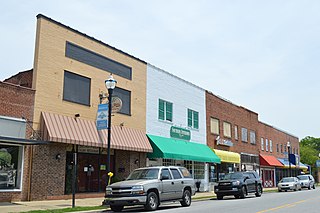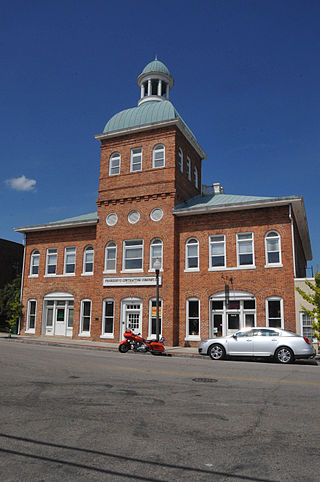
Ahoskie is a town in Hertford County, North Carolina, United States. The population was 5,039 at the 2010 census. Ahoskie is located in North Carolina's Inner Banks region. Its nickname is "The Only One" because no other town in the world is known by the same name. The etymology of the word Ahoskie, which was originally spelled "Ahotsky", was from the Wyanoke Indians, who entered the Hertford County area at the beginning of European settlement.

Winton is a town and the county seat of Hertford County, North Carolina, United States. It is governed by the Town Council which consists of a Mayor and five Council members. The population was 769 at the 2010 census.

The Downtown Main Street Historic District is a national historic district located at North Wilkesboro, Wilkes County, North Carolina. It encompasses 29 contributing buildings in the central business district of North Wilkesboro. It developed between about 1891 and 1952, and includes notable examples of Classical Revival and Early Commercial style architecture. The architectural firm Benton & Benton designed the former Bank of North Wilkesboro II (1923), the Hotel Wilkes (1926), and the former Town Hall (1939). Other notable buildings include the Liberty Theater, former Bank of North Wilkesboro (1892), and Tomlinson Department Store (1927).

Downtown Burlington Historic District is a national historic district located at Burlington, Alamance County, North Carolina, United States. It encompasses 40 contributing buildings in the central business district of Burlington, and was added to the National Register of Historic Places in 1990.
Downtown Asheville Historic District is a national historic district located at Asheville, Buncombe County, North Carolina. The district encompasses about 279 contributing buildings and one contributing object in the central business district of Asheville. It includes commercial, institutional, and residential buildings in a variety of popular architectural styles including Colonial Revival, Queen Anne, and Art Deco.

Downtown Durham Historic District is a national historic district located at Durham, Durham County, North Carolina. The district encompasses 97 contributing buildings and 1 contributing structure in the central business district of Durham. The buildings primarily date from the first four decades of the 20th century and include notable examples of Colonial Revival, Italianate, and Art Deco architecture. Notable buildings include the St. Philip's Episcopal Church (1907), Durham Arts Council Building (1906), First Presbyterian Church (1916), Trinity United Methodist Church (1880-1881), First Baptist Church (1926-1927), Durham County Courthouse (1916), Carolina Theatre of Durham, (1920s), Tempest Building, National Guard Armory (1934-1937), United States Post Office (1934), Trust Building (1904), First National Bank Building (1913-1915), Mechanics and Farmers Bank (1921), Johnson Motor Company showroom (1927), Hill Building (1935), Snow Building (1933), and S. H. Kress store.

Belmont Historic District is a national historic district located at Belmont, Gaston County, North Carolina. It encompasses 264 contributing buildings, 1 contributing site, and 2 contributing structures in the central business district and adjacent residential areas of Belmont. The district was developed after 1873, and includes notable examples of Colonial Revival, Tudor Revival, and Bungalow / American Craftsman architecture. Located in the district is the separately listed U.S. Post Office, Former. Other notable buildings include the R.L. Stowe Mills Office Building, Bank of Belmont (1926), Piedmont and Northern Railroad Depot, Belmont Hotel, Abel C. Lineberger House No. 2 designed by Charles Christian Hook (1870–1938), Samuel Pinckney Stowe House, James W. Stowe House, Sacred Heart College, and Belmont High School (1939).

Ahoskie Historic District is a national historic district located at Ahoskie, Hertford County, North Carolina. The district encompasses 604 contributing buildings, 1 contributing site, and 2 contributing structures in the central business district and surrounding residential sections of Ahoskie. The buildings include notable examples of Classical Revival, Colonial Revival, Late Gothic Revival, Tudor Revival, and Bungalow / American Craftsman architecture. The district includes the separately listed Ahoskie School and Roberts H. Jernigan House and encompasses the previously listed Ahoskie Downtown Historic District. Other notable buildings include The Tomahawk Motel, Ahoskie Food Center, Thomas Wright Hayes House, Basnight & Company Building, Ahoskie United Methodist Church, St. Thomas Episcopal Church, and North Carolina Mutual Insurance Company.
East End Historic District is a national historic district located at Ahoskie, Hertford County, North Carolina. The district encompasses 27 contributing buildings and 1 contributing structure in a predominantly African-American residential section of Ahoskie. The buildings include notable examples of Colonial Revival architecture. Notable buildings include the 12 buildings and racetrack at the Atlantic District Fairgrounds and 3 brick buildings at the Robert L. Vann Elementary and High School complex.

Murfreesboro Historic District is a national historic district located at Murfreesboro, Hertford County, North Carolina. The district encompasses nine contributing buildings in the oldest section of the city of Murfreesboro. The buildings include notable examples of Greek Revival style architecture. They are the William Rea Store ; John Wheeler House birthplace of John H. Wheeler (1806-1882) and later home of Congressman Jesse Johnson Yeates (1829-1892); Myrick House ; Melrose home of Congressman William H. Murfree ; The Hertford Academy ; Roberts-Vaughan House ; Dr. Isaac Pipkin House ; Rose Bower ; and the Walter Reed House childhood home of Walter Reed.
William Mitchell House is a historic home located near Ahoskie, Hertford County, North Carolina. It was built about 1832, and is a two-story, five-bay-by-two-bay, L-shaped Federal style frame dwelling, with Greek Revival style design elements. It has a shallow gable roof and brick pier foundation. Also on the property are the contributing office, schoolhouse, carriage house, and smokehouse. It was the home of William Mitchell, one of the founders of Chowan University.

Ahoskie School is a historic school complex located at Ahoskie, Hertford County, North Carolina. The main school building was designed by architect Leslie Boney and built in 1929. It is a two-story, Classical Revival-style brick building. Associated with the school are the contributing one-story brick agricultural building (1937), a one-story brick home economics building (1940), a brick and concrete block gymnasium (1940), an athletic field, and a Department of Transportation highway historical marker commemorating the site of the first 4-H club in North Carolina (1955).

Downtown Sylva Historic District is a national historic district located at Sylva, Jackson County, North Carolina. The district encompasses 41 contributing buildings and 3 contributing structures in the central business district of Sylva. They are dated between about 1900 and 1964, and include notable examples of Italianate, Classical Revival, Modern Movement, Queen Anne, and American Craftsman style architecture. Notable buildings include the C. J. Harris Building, New Jackson Hotel, Medford Furniture Company (1923), Great Atlantic and Pacific Tea Company (1925), the Sylvan Theatre (1927) designed by architect Douglas Ellington, Jackson County Bank's Sylva branch (1926), Cogdill Motors (1934), Moody Funeral Home (1946), Saint John's Episcopal Church (1956), and the United States Post Office (1964).

Downtown Sanford Historic District is a national historic district located at Sanford, Lee County, North Carolina. It encompasses 53 contributing buildings in the central business district of Sanford. The district includes notable examples of Colonial Revival, Tudor Revival and Art Deco style architecture, with buildings largely dated between about 1895 to 1930. Located in the district are the separately listed Railroad House and Temple Theatre. Other notable buildings include the Sanford Buggy Company, McCracken Building, Passenger Depot, City Hall, Coca-Cola Bottling Company, Masonic Lodge, Makepeace Building (1924), Wilrick Hotel (1925), Bowers Building, Cole Pontiac Building, Hubbards Shoe Store (1926), Carolina Hotel (1930), and former U. S. Post Office.

Star Historic District is a national historic district located at Star, Montgomery County, North Carolina. The district encompasses 85 contributing buildings, 2 contributing sites, and 3 contributing structures in the town of Star. The district developed between 1896 and 1963 and includes notable examples of Queen Anne, Romanesque Revival, Colonial Revival, and American Craftsman style architecture. Notable contributing resources include the Leach-Allen House and Wright Dairy, Leach Cemetery (1859), Star Railroad Depot, Bank of Star, Star Hotel (1896), Allen Building, Pontiac Dealership, Nalls Watch Repair Building/C. V. Richardson Hosiery/Star Town Hall, Star Methodist Church, and Star Presbyterian Church (1953-1958).

Hertford Historic District is a national historic district located at Hertford, Perquimans County, North Carolina. The district encompasses 219 contributing buildings, 2 contributing sites, 1 contributing structure, and 1 contributing object in the central business district and surrounding residential sections of Hertford. The district developed between about 1759 and 1948, and includes notable examples of Federal, Greek Revival, and Gothic Revival style architecture. Located in the district are the separately listed Perquimans County Courthouse and Church of the Holy Trinity. Other notable buildings include the Creecy-Skinner-Whedbee House, Edward Wood House, Matthews-Jacocks House, Temperance Hall (1851), Matthew H. White House, Dr. Thomas S. McMullan House (1905), Thomas Nixon House, William M. Divers House (1924), W.R. Shannonhouse Building (1895), Darden Department Store, Farmers National Bank of Hertford (1916), State Theatre (1937), Old Hertford Post Office (1915), Hertford Baptist Church (1854), and Hertford United Methodist Church (1901).

Reidsville Historic District is a national historic district located at Reidsville, Rockingham County, North Carolina. It encompasses 324 contributing buildings, 1 contributing site, 11 contributing structures, and 1 contributing object in the central business district and surrounding residential sections of Reidsville. It was developed between about 1865 and 1941, and includes notable examples of Italianate, Queen Anne, American Craftsman, and Classical Revival style architecture. Located in the district are the separately listed Penn House and Gov. David S. Reid House. Other notable buildings include the Oaks-Motley House, Colonel A. J. Boyd House (mid-1870s), Reid Block (1880s), Citizens' Bank Building, William Lindsey and company Tobacco Factory, First Baptist Church, Main Street Methodist Church, Melrose (1909) designed by architect Richard Gambier, R. L. Watt house designed by Willard C. Northup, First Presbyterian Church (1922), St. Thomas Episcopal Church, Grand Theatre, Belvedere Hotel, United States Post Office and Federal Building, and the Municipal Building (1926).
Salisbury Historic District is a national historic district located at Salisbury, Rowan County, North Carolina. The district encompasses 348 contributing buildings and 1 contributing site in the central business district and surrounding residential sections of Salisbury. It includes notable examples of Late Victorian, Colonial Revival, and Bungalow / American Craftsman style architecture. Located in the district are the separately listed Maxwell Chambers House, McNeely-Strachan House, Archibald Henderson Law Office, and the former Rowan County Courthouse. Other notable buildings include the tower of the former First Presbyterian Church (1891-1893), Rowan County Courthouse (1914), Conrad Brem House, Kluttz's Drug Store, Bell Building, Washington Building, Grubb-Wallace Building, Hedrick Block, Empire Hotel, St. Luke's Episcopal Church (1827-1828), Soldiers Memorial A.M.E. Zion Church (1910-1913), U.S. Post Office and Courthouse (1909), City Hall (1926), Salisbury Fire House and City Building (1897).

College Street Historic District is a national historic district located at Clinton, Sampson County, North Carolina. The district encompasses 22 contributing buildings in a predominantly residential section of Clinton. It developed between about 1840 to the 1930s, and includes notable examples of Greek Revival, Colonial Revival, and Classical Revival architecture. Located in the district is the separately listed Graves-Stewart House. Other notable buildings include the Colonel John Ashford House, College Street Elementary School (1911), John R. Beaman House (1850s), Hobbs-Matthews-Small House, Dr. Fleet Rose Cooper House (1890s), Jim McArthur House (1905–1910), Kate Powell House, Henry L. Stewart House (1926), Dr. R. A. Turlington House, Carroll-Morris House, and Turlington Rental House (1929).

Main Street Historic District is a national historic district located at Brevard, Transylvania County, North Carolina. It encompasses 32 contributing buildings in the central business district of Brevard. The district developed between about 1874 and 1952 and includes notable examples of Early Commercial, Second Empire, and Classical Revival style architecture. Located in the district are the separately listed McMinn Building and Transylvania County Courthouse. Other notable buildings include the Lowe Auto Company, Brevard Banking Company (1924), Brevard Drugs/Mull's Grocery, Brevard City Hall and Fire Station (1926), Plummer's Department Store (1911), Brevard Banking Company (1924) designed by Erle Stillwell, Co-ed Theater (1939), Pearlman's (1952), Aethelwold Hotel, and City Market.




















